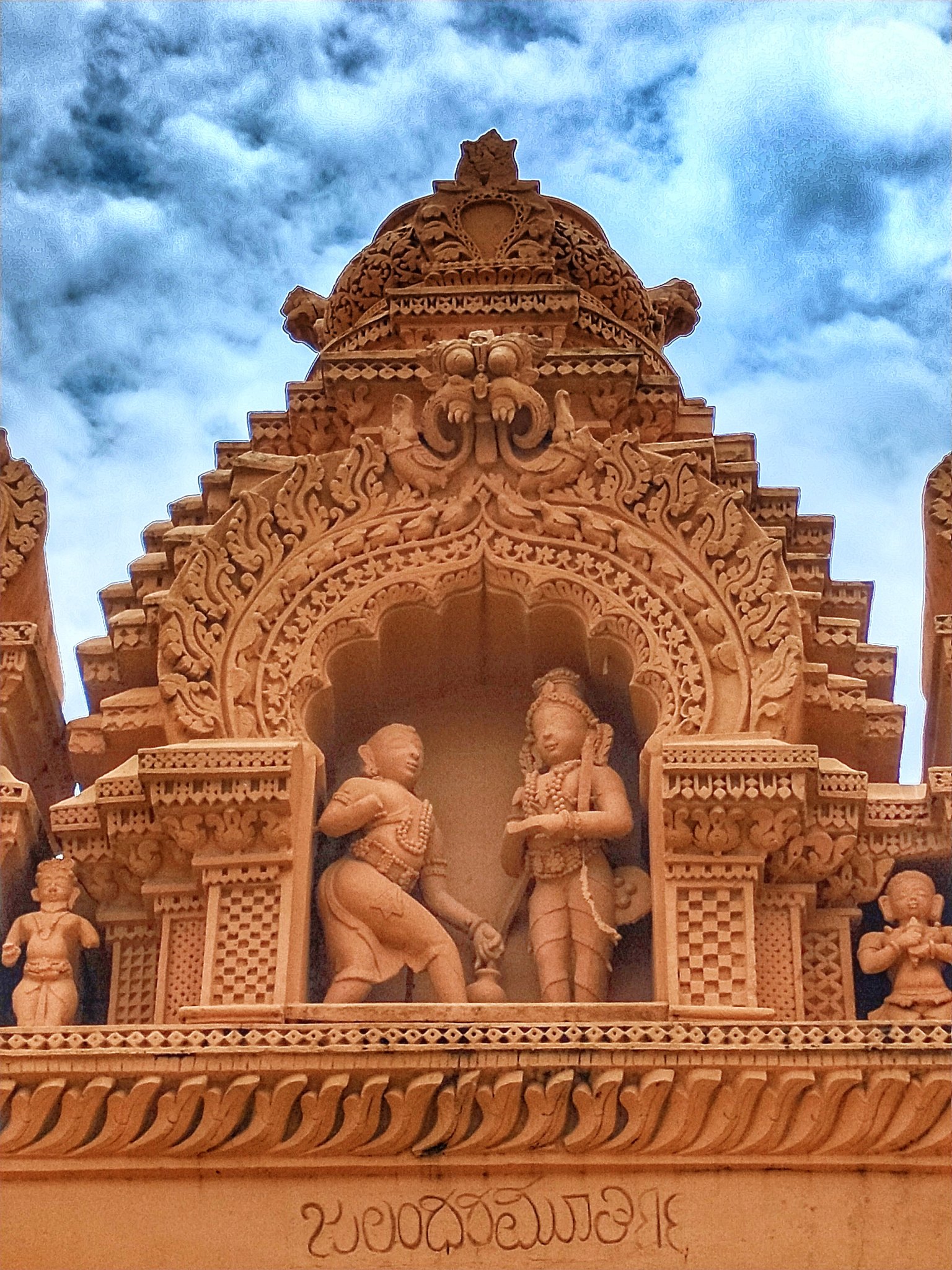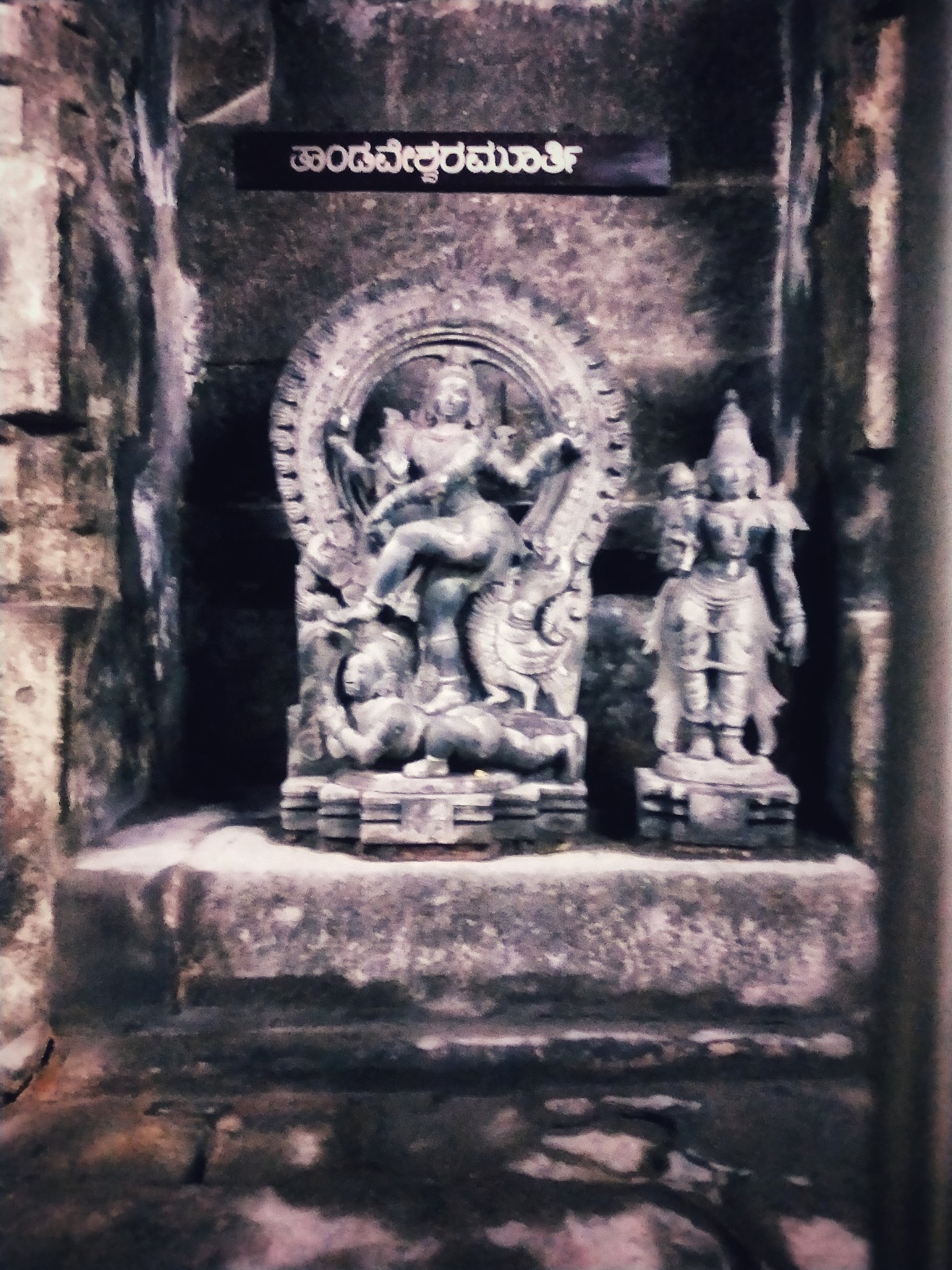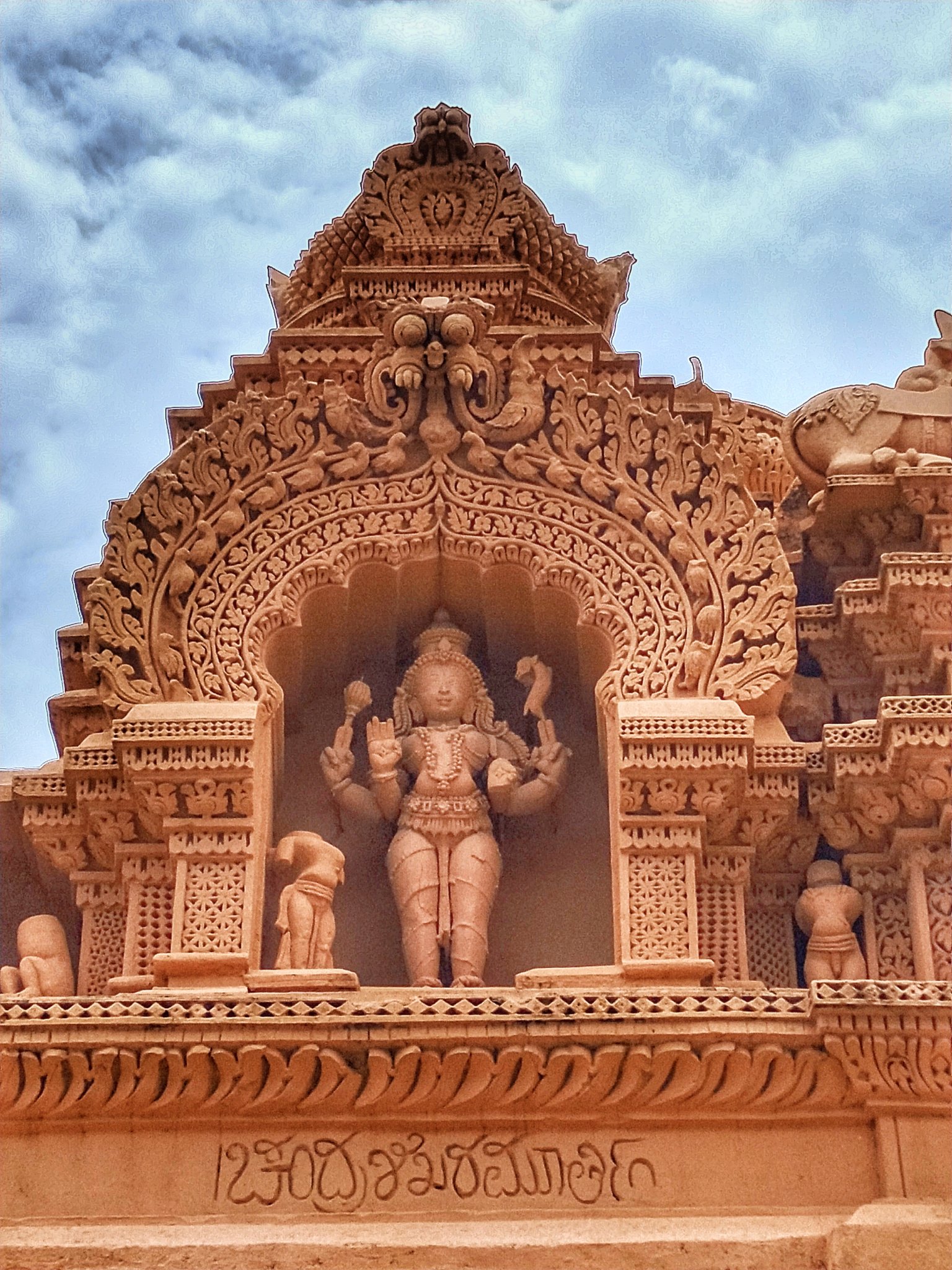 |
| Aghora, Lingodbhava, Gajasurasmahara & Bhairava aspects of Lord Shiva |
On the occasion of Maha Shivaratri, here's my writeup on the many manifestations of Lord Shiva from the Srikanteshwara Swamy Temple at Nanjangudu near Mysuru in Karnataka. The iconography related to these forms of Lord Shiva find mention in the Sritattvanidhi, a treatise written by the then Maharaja of Mysore, Shri Krishnaraja Wodeyar III.
Together these 25 forms are called Panchavimshatililamurti. All these manifestations are based on Puranas like the Shiva Purana & Shiva Agama texts. Apart from the Panchavimshatililamurti described in the Sritattvanidhi, we'll also be taking a look at few additional aspects of Lord Shiva which form the basis of the Ashdashta Murtas i.e. 64 different forms of Shiva as described in the Shaiva Siddhanta texts.
 |
| Harihara, Ardhanarishwara, Brahmashiraschedaka & Veerabhadra. |
1) Srikanteshwara
 |
| Srikanteshwara |
Srikanteshwara also known as Nanjundeshwara(the Lord who swallowed the poison) & Neelakanta (blue necked one) represents a manifestation of Lord Shiva during which he drinks the Halahala poison which appears as a result of Samudra Mantan. Here's a murthi of Lord Shiva with Goddess Parvathi Devi tightly holding onto his neck to prevent the poison from further entering the body. Hence the name Vishakanta.
2) Kalasamharamurthi
 |
| Kalasamharamurthi |
 |
| Kalasamharamurthi |
Lord Shiva manifests as Kalasamharamurthi (the vanquisher of time & death) to save his bhakta Markandeya from the wrath of Lord Yama who was determined to take away his life just at the tender age of 16. Moved by Markandeya's bhakti & enraged by Yama's decision to take away Markandeya's life, Lord Shiva manifests from the lingam when Yama's noose accidentally touches the lingam to which Markandeya was hugging onto tightly. (Observe closely, you can spot the carving of the noose around the lingam in pic 1) An enraged Kalasamhara kills Yama & grants immortality to Markendeya. Later at the pleading of other Devas, Lord Shiva restores Yama's life.
3) Tripurantakamurthi
 |
| Tripurantakamurthi |
 |
| Tripurantakamurthi |
Lord Shiva manifests as Tripurantakamurthi to destroy the 3 forts constructed by the 3 children(Taarakaaksha, Kamalaaksha and Vidyunmaali) of evil asura Taraka, who were wrecking havoc on the inhabitants of the 3 lokhas. Lord Shiva takes aim destroys each of the 3 forts with a shot of a single arrow. In this aspect Lord Shiva is depicted with four arms wielding a bow and arrow. He holds an axe & a galloping antelope on the upper pair of his arms. In the lower pair of the arms he holds a bow & an arrow. After burning down Tripurasura's forts, Tripurantaka applies its ashes on his forehead (Tripundra). He also performs a Rudra Tandava known as Tripuratandava right after this(will write on the different Tandavas in a separate post)
4) Jalandharamurthi
 |
| Jalandharamurthi |
 |
| Jalandharamurthi |
Jalandharamurthi, who is the creation of Lord Shiva himself, though he turns out to be asuric in nature. Jalandhara was said to be created from Shiva's 3rd eye when Lord Indra infuriates him.He is born from the ocean & turns out all powerful. Finally he is subdued by Shiva himself. He carries a Chattri & a Kamandala. Also wears Padaraksha (footwear).
5) Shankaranarayana
 |
| Shankaranarayana |
Shankaranarayana also known as Harihara. A manifestation of Lord Shiva & Lord Maha Vishnu in a single form. What better shloka than the one below to appreciate the essence of this deity.
शिवाय विष्णु रूपाय शिव रूपाय विष्णवे |
शिवस्य हृदयं विष्णुं विष्णोश्च हृदयं शिवः ||
Meaning: Shiva and Vishnu are one & the same entity. They are essentially one & the same. They are the names given to the different aspects of the all pervading Supreme Parabrahman.
At the base of the murthi you can also notice the carvings of Vahanas of both Shiva & Vishnu. Vrishaba & Garuda. While the Shiva part holds a Abhayamudra (gesture of reassurance), Vishnu holds the Varadhamudra(gesture of boon giving)
6) Ardhanarishwara
 |
| Ardhanarishwara |
 |
| Ardhanarishwara |
Ardhanarishwara, one of the most popular iconography across all regions of Bharat. Ardhanarishwara represents how Shiva & Shakti are inseperable & how they are one & the same. The right half is Shiva & the left half is Parvati. Shiva holds the Abhayamudra & Parvathi the Varadhamudra.While Shiva holds a Parashu(axe) in his upper arm, the Devi holds a Kamala pushpa (Lotus flower).
7) Brahmashiraschedakamurthi
 |
| Brahmashiraschedakamurthi |
Seen here is a fearsome aspect of Lord Shiva known as Brahmashiraschedaka murthi. Shiva manifests in this form when he beheads Lord Brahma of his 5th head which was a personification of ego & arrogance. Seen in Shiva's left front arm is Brahma's severed 5th head.
8) Bhikshatanamurthi
 |
| Bhikshatanamurthi |
 |
| Bhikshatanamurthi |
This aspect of Lord Shiva is known as Bhikshatanamurthi. He is depicted as a Bhikshuka(beggar) here. Shiva assumes this form to atone for the terrible paapa of having severed Brahma's 5th head in his previous roopam as Brahmashiraschedakamurthi. Seen in his left arm is a bowl. He has 4 arms,front right arm feeding the deer with grass,back right arm holds a damaru, front left hand holds a kapala (bowl) back left hand holds a trishula. He is accompanied by a Bhutagana (attendant) who carries a bowl over his head.
Lord Shiva wanders all the 3 lokhas in the form of Bhikshatana & finally is relived of his paapa of having severed Lord Brahma's when he reaches Varanasi. You'd have heard of "Brahmahatya"...its associated with Bhikshatana
9) Kankalamurthi
 |
| Kankalamurthi |
 |
| Kankalamurthi |
Kankalamurthi, an aspect of Shiva closely related to the previous two.Shiva as Bhikshatana approaches the gates of Vaikunta begging for food where he is denied entry by Vishvaksena, gate keeper of Vaikunta. Angered by his action, Bhikshatana transforms into Kankala & slays him using his Musala(Club)
This extreme action of Lord Shiva only further compounds his already existing accumulated paapa of having severed off Brahma's 5th head. Now he had the additional burden of carrying Vishvaksena's corpse along with Brahma's head.
Desperate to rid himself of the paapa, Shiva seek's Vishnu's advice. Lord Vishnu directs Shiva( now in the form of Kankalamurthi) to visit Varanasi where he would get Vimochana from all his paapa. Shiva follows this advice. He wanders all the 3 worlds before reaching Varanasi.
On reaching Varanasi, Brahma's skull falls off & Vishaksena's corpse disappears. Lord Shiva transforms from Kankalamurthi to his original form & is relieved of his paapa. There is a Kapalamochana Temple to this day in Varanasi. Such is Kashi's significance in Hindu Dharma.
10) Kiratarjuniyamurthi
 |
| Kiratarjuniyamurthi |
 |
| Kiratarjuniyamurthi |
Kiratarjuniya murthi. Lord Shiva assumes the form of a hunter & engages Arjuna in an epic battle which involves the slaying of an asura named Mukasura who assumes the form of a boar. Arjuna finally concedes defeat. He receives the Pashupatasthra as seen here for his valiance.
A little more background on the above episode.
During their exile period in the forest, Draupadi urges the Pandavas to declare war against against the Kauravas. While Bhima agrees.. Arjuna as usual is left in two minds & confused. The final word however was with Yudhishthira. He decides against any such action.
The confused Arjuna not knowing what to do proceeds to embark on a vigorous penance to please Lord Shiva. Lord Shiva decides to put Arjuna to the test & sends an asura called Mukasura to scuttle Arjuna's penance. Mukasura assumes a form of a wild boar & charges towards Arjuna. Meanwhile Lord Shiva too descends to Bhoolokha in the form of a Kirata(hunter).
An enraged Arjuna shoots an arrow at the charging Mukasura in an attempt to kill him for disturbing his penance. Simultaneously Kirata too shoots an arrow. It results in the death of Mukasura. Following this an argument ensues between Kirata & Arjuna as to who killed the boar.
What followed next was a ferocious battle between Arjuna & Kirata as depicted here. Its a epic battle that lasts of days. Arjuna despite his ace fighting skills isn't able inflict any damage on this hunter. He is left amazed.
It finally dawns on Arjuna that he is fighting none other than Lord Shiva himself & surrenders. Pleased with Arjuna's bhakti, Lord Shiva grants Arjuna one of the most powerful weapons, the Pashupatasthra, which Arjuna eventually uses to kill evil Jayadratha at Kurukshethra.
11) Chandikeshwaraprasannamurthi
 |
| Chandikeshwaraprasannamurthi |
 |
| Chandikeshwaraprasannamurthi |
Chandikeshwaraprasannamurthi, also called Chandeshanugrahamurthi. In this aspect Shiva along with Parvathi are depicted as blessing Chandeshwara, one of the 63 Nayanmars(Shaivaite saints) Chandeshwara is regarded as the guardian of Temple wealth & has a separate shrine in the NE direction of every Shiva Temple. The most famous depiction of this episode carved at the Gangaikonda Cholapuram temple.
12) Chakaradanamurthi
 |
| Chakaradanamurthi |
 |
| Chakaradanamurthi |
13) Somaskandamurthi
 |
| Somaskandamurthi |
 |
| Somaskandamurthi |
Somaskandamurthi. A representation of Lord Shiva which depicts him seated with Parvathi devi with the child Skanda in between them. At times the child Skanda is depicted even dancing. Both Shiva & Parvathi hold the Abhaya & Varada mudra. While Shiva holds a Parashu(axe) & a galloping antelope with his upper arms.
14) Ekapadamurthi
 |
| Ekapadamurthi |
 |
| Ekapadamurthi |
Ekapadamurthi. Here Shiva is depicted as one legged & 4 armed with torsos of Brahma & Vishnu appearing on either side. Together referred to as Ekapada-trimurthi. Lord Shiva holds a Trishula & Tanka in his rear arms while keeping the varada & abhaya mudra in the front arms. The Vishnu aspect is unfortunately damaged in the stucco sculpture.
15) Dakshinamurthi
 |
| Vatamoola Dakshinamurthi |
 |
| Dakshinamurthi |
Dakshinamurthi, the Guru(teacher) aspect of Lord Shiva. Here he is depicted as sitting beneath the Vata vruksha(Banyan tree) accompanied by his disciples. The tree represents the expanding universe,suggesting Dakshinamurthy presides over the cyclic process of sristhi(creation), sthiti(preservation) & samhara(absorption).
The above particular iconography of Dakshinamurthi is known as Vatamoola Dakshinamurthi. There are additional forms of Dakshinamurthi. I have written on those forms which can be read Here
16) Vrishabarudamurthi
 |
| Vrishabarudamurthi |
 |
| Vrishabarudamurthi |
Vrishabarudamurthi. An aspect of Lord Shiva where he is depicted seated on his Vahana along with Parvathi devi. More on this aspect. Unable to bear the atrocities of the asura trio of Tripurasura, the Devas approach Shiva for help at Kailasa. A specially made chariot is given by the devas to Shiva to take the fight to Tripurasura. On the way to the battle the axle of the chariot breaks.
Just as the chariot is about to fall, Maha Vishnu stabilizes & prevents the chariot from falling. Vishnu for a moment is filled with pride that he is the only one in the entire universe capable of bearing the weight of Shiva.
Lord Shiva meanwhile increases his weight to an extent that Maha Vishnu is no longer able to support the chariot. He gives up. This is the story behind this manifestation. This is followed up by the slaying of Tripurasura, where Shiva, Brahma & Vishnu team up to slay the asuras.
17) Thandaveshwaramurthi
 |
| Thandaveshwaramurthi |
 |
| Thandaveshwaramurthi |
Thandaveshwaramurthi. An aspect of Lord Shiva depicting him performing the cosmic dance. Under his foot is the Apasmara, who is the personification of ignorance.Standing besides Lord Shiva is Goddess Gowri. There are 7 additional aspects of this particular form of Shiva. I'll be elaborating on it in a different post shortly.
18) Veerabhadra
 |
| Veerabhadra(center), Daksha(left) & Kali(right) |
 |
| Veerabhadra & Daksha |
 |
| Veerabhadra(center), Daksha(left) & Kali(right) |
Veerabhadra. A fearsome manifestation of Lord Shiva who destroys Daksha Prajapati's yagna, beheading him for insulting Sati; Daksha's daughter who self immolates. Also seen standing besides Veerabhadra is Daksha, who is later forgiven & given a goat's head.
19) Lingodbhavamurthi
 |
| Lingodbhavamurthi |
Lingodbhavamurthi. On the left is a small 3 headed figurine that is actually Brahma. The one on the right (damaged) is Vishnu. Brahma & Vishnu take the forms of a swan & a boar to investigate the origins of Shiva who appears as a flame.
20) Chandrashekaramurthi
 |
| Chandrashekaramurthi |
Chandrashekaramurthi. When Lord Shiva partially relieves Chandra of a curse he receives from his father-in-law Daksha for failing to take proper care of his wives. The curse lifts when Shiva places Chandra on his his matted hair. Its the story of waxing & waning of the moon.
21) Uma Maheshwaramurthi
 |
| Uma Maheshwaramurthi |
22) Kalyanasundara murthi
 |
| Kalyanasundaramurthi |
The marriage leads to the birth of Kumara, who slays Tarakasura. Also on the wedding day is when Manmatha is reborn, after he was reduced to ashes by Shiva for striking him with the arrow of flowers to induce love towards Uma at the request of Lord Indra.
Also on the day of wedding is when the balance of the earth tilts heavily northwards when all the beings head north to witness the wedding. Lord Shiva sends Sage Agastya southwards to restore balance. Agastya is highly revered in Dakshina Bharat even to this day.
23) Kamasamhara murthi
 |
| Kamasamharamurthi |
Kamasamhara murthi. In an attempt to save the world from Tarakasura, Manmatha attempts to wake Shiva from deep penance,which results in Shiva opening his 3rd eye & reducing him to ashes.Kama is seen sitting on a parrot wielding a bow made of sugarcane & arrows made of flowers.
24) Gajasurasamharamurthi
 |
| Gajasurasamharamurthi |
Gajasurasamhara murthi. Gajasura, an evil asura capable of maya assumes the form of an elephants to terrorize the Shiva bhaktas of Varanasi. Lord Shiva appears out of the lingam to slay Gajasura. This iconography is extensively seen in Hoysala & Chola built temples.This iconography was also very popular in Pala ruled Bengal. It disappeared with the onslaught of islamic barbarians.
25) Aghoramurthi
 |
| Aghoramurthi |
Aghoramurthi. He has a single face & 32 arms. On his head is a jata-makuta & chandra on it. The right hand holds Abhaya mudra. Also seen on upper rightarms are khadga, sula, chakra, damaru, bana, gada, kamala, kapala, jnanamudra, kunda, ankusa, askhamala, khatvanga and parasu. Aghoramurthy holds the Varadamudra with his left hand. Upper left arms hold a kavacha, tanka, paasa, mudgara, sarpa, agni, mriga, ghanta, dhanus, katyavalambita hasta, ratnas, a lily flower, musala & a pustaka.
27) Simhaghnamurthi
 |
| Sharabeshwaramurthi |
Simhaghnamurthi. Sometimes referred to as Sharabeshwaramurthi. Lord Shiva assumes this form of a fierce lion-bird to pacify Lord Vishnu who is in his Ugra Narasimha avatara just after slaying Hiranyakishapu.
28) Sukasanamurthi
 |
| Sukhasanamurthi |
Sukasanamurthi. Lord Shiva is seated in a relaxed posture, extending the Abhaya & Varada mudra with his left leg folded & the right leg handing. This form describes his posture at Kailasa. Lord Shiva is sitting in the posture of ease.
29) Bhairava
 |
| Bhairava |
Bhairava. He his accompanied by his vahana Shvana (dog). Interestingly he holding the Abhaya & Varada mudra with his arms (damaged here) as opposed to any weapons we are used to seeing. There are an additional 8 aspects of Bhairava depicted at the temple. I'll write about those in the separate post.





